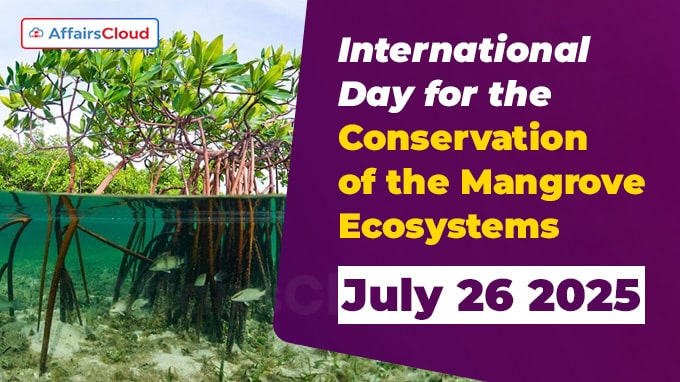 The United Nations Educational, Scientific, and Cultural Organization (UNESCO) observes the International Day for the Conservation of the Mangrove Ecosystems, also known as World Mangrove Day, every year on 26 July to raise global awareness about the significance of mangrove ecosystems. These ecosystems thrive at the boundary of land and sea, where very few tree species can survive.
The United Nations Educational, Scientific, and Cultural Organization (UNESCO) observes the International Day for the Conservation of the Mangrove Ecosystems, also known as World Mangrove Day, every year on 26 July to raise global awareness about the significance of mangrove ecosystems. These ecosystems thrive at the boundary of land and sea, where very few tree species can survive.
- July 26, 2025, marks the 10th observance of International Day for the Conservation of the Mangrove Ecosystems.
Theme:
2025 Theme: The theme for the International Day for the Conservation of the Mangrove Ecosystems 2025 is “Protecting Wetlands for our future”.
Focus: It emphasizes the crucial role of mangroves as natural-based solutions, particularly in carbon storage, sequestration, and climate change mitigation.
Background:
Proclamation: In 2015, during its 38th session, UNESCO adopted Resolution 38 C/66, officially proclaiming 26 July as the International Day for the Conservation of the Mangrove Ecosystems.
First Observance: Held on 26 July 2016, marking the beginning of global recognition and awareness efforts towards mangrove conservation.
Tribute: The date 26 July also honours the memory of Hayhow Daniel Nanoto, a Greenpeace activist from Micronesia, who lost his life on 26 July 1998 during a protest aimed at restoring mangrove wetlands in Muisne, Ecuador.
About Mangroves:
What Are Mangroves? Mangroves are salt-tolerant trees and shrubs that grow in tropical and subtropical intertidal zones.
Key Benefits: These ecosystems provide:
- Coastal protection by reducing the impact of storms, tsunamis, and erosion.
- Nursery habitats for fish, crustaceans, and other marine species.
- Blue carbon sinks store large amounts of carbon in their soil.
- Livelihoods through fisheries, forest products, and tourism.
- Adaptations to low-oxygen soil conditions make their biodiversity unique and highly resilient.
Significance of Mangroves:
Natural Coastal Defence: Reduce wave height by 50–99% over 500 meters (m), shielding coastal communities from natural disasters.
Biodiversity Hotspots: Home to a wide range of species, including crocodiles, birds, tigers, monkeys, reptiles, and crustaceans.
Carbon Sequestration: Covering only 0.7% of tropical forests, they contribute 10–11% of terrestrial carbon input to oceans and store 3–4 times more carbon per hectare than other tropical forests.
Livelihood and Food Security: Provide biomass, fisheries, and forest products, stabilizing local economies and food chains.
UNESCO’s Role in Mangrove Conservation:
UNESCO includes mangrove ecosystems in its network of Biosphere Reserves, Global Geoparks, and World Heritage Sites(WHS) to promote their protection and sustainable use.
Mangrove Carbon Protection: Marine WHA under UNESCO contain about 9% of the world’s mangrove carbon assets, highlighting their role in global carbon storage.
Restoration of Blue Carbon Ecosystems: UNESCO undertakes scientific and policy-based actions to restore blue carbon ecosystems, including mangroves, seagrasses, and tidal marshes, which are crucial for climate resilience.
MangRes Project (2022–2025): The MangRes Project aims to combat invasive species like African oil palm and engage local communities in conservation efforts across Latin America and the Caribbean.
Global Status and Threats:
Decline: Mangroves are disappearing at a rate 3–5 times faster than global forests.
Loss: 50% of mangrove forests have been lost since 1980.
Threats: Over 75% of the remaining mangroves are under threat from aquaculture, deforestation, and urban expansion.
Climate Change Impact: Climate change threatens 33% of existing mangroves through rising sea levels and temperature variations.
IUCN Warning: According to the International Union for Conservation of Nature (IUCN), without urgent action, 50% of mangroves could collapse by 2050.
Global Mangrove Alliance (GMA):
The GMA was established in 2018 as a coalition of governments, Non-Governmental Organizations (NGOs), scientists, and industry leaders to promote global mangrove conservation.
Objectives:
- Halt mangrove loss by 2030
- Restore 50% of lost mangroves
- Double global mangrove protection
Mangrove Breakthrough Initiative:
- Protect 15 million hectares of mangroves globally by 2030
- Mobilize investments worth USD 4 billion to support this target
Mangrove Coverage Overview:
Global Cover (2020): 14.8 million hectares (<1% of tropical forests), led by Indonesia, Brazil, Nigeria, Mexico, and Australia (47% combined).
India’s Cover (2023): According to the India State of Forest Report 2023, India has a total mangrove cover of 4,991.68 sq km, which constitutes just 0.15% of its total geographical area.
- West Bengal(WB) leads with the largest mangrove cover, encompassing 2,119.16 sq km.
- Puducherry has the smallest mangrove cover among Indian states, with 3.83 sq km.
Key Regions:
- Sundarbans (WB): World’s largest contiguous mangrove forest in the world, a UNESCO WHS.
- Bhitarkanika (Odisha): India’s second-largest mangrove ecosystem.
- Others: Significant mangrove ecosystems are also found in Gujarat, Pichavaram (Tamil Nadu, TN), and the Godavari-Krishna delta (Andhra Pradesh, AP).
Conservation projects in India:
MISHTI scheme: The Mangrove Initiative for Shoreline Habitats & Tangible Incomes (MISHTI) scheme was launched by the Government of India (GoI) in 2023 to expand India’s mangrove cover and enhance coastal resilience.
- Objective: Restoration of approximately 540 sq. km of mangrove habitats
- Timeline: Over five years (2023–2028)
- Focus: Climate resilience, shoreline protection, and community-based income generation
Mangrove Alliance for Climate (MAC): Launched at the 27th United Nations Conference of the Parties (COP27) in 2022, held in Egypt, to promote the conservation and restoration of mangrove ecosystems worldwide.
- Led by: The United Arab Emirates (UAE) and Indonesia
- Focus: Climate change mitigation and adaptation, biodiversity conservation, and promoting international cooperation.
- MAC Member Countries: Indonesia, UAE, Spain, Australia, Japan, India, and Sri Lanka.
About United Nations Educational, Scientific and Cultural Organisation (UNESCO):
Director-General (DG) – Audrey Azoulay
Headquarters – Paris, France
Established – 1945




